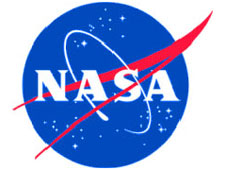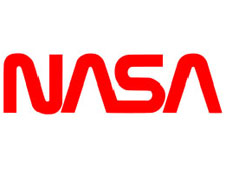NASA’s design choices — in particular, their iconic “meatball” and “worm” logos — have long been a source of public fascination, and no one is better aware of this than Dr. Bill Barry. Barry has served as NASA’s Chief Historian since 2010. His tenure with NASA began in 2001; prior to his current role, he served as NASA’s European Representative at the United States Embassy in Paris and as a Senior International Programs Specialist in NASA’s Office of External Relations.
18F Design Presents is extremely happy to be welcoming Dr. Barry to the 18F headquarters on Friday, March 4, for a discussion of NASA’s logos and the importance of design to government missions. In preparation for the event, we had an email conversation with Dr. Barry about the meatball (and more). Read on for the full conversation.
Kate Garklavs: NASA switched from “the meatball” logo, pictured here:

to “the worm”, pictured here:

in 1975 — how was that decision received, internally? How did the public react to this transition, and how did the public reaction reflect (or deviate from) what NASA expected?
Dr. Bill Barry: The change from the NASA Insignia (the “meatball”) to the NASA Logotype (the “worm”) came as a complete surprise to most NASA staff. The rebranding was part of a larger government-wide Federal Graphics Improvement Program and only a limited number of people at NASA Headquarters had any knowledge that the change was in the works. Coming on the heels of the post-Apollo reductions and cutbacks, this was largely seen as another blow against the aspirations of NASA employees to have an energetic space exploration program. Public reaction was relatively muted — this just wasn’t a big issue for the public — though the elegance of the logotype and the thoughtful work done in preparing it paid off as the public quickly recognized the new logo and embraced it.
Among those involved in the redesign, the expectation was probably that the newer, more modern design would rebrand NASA as an agency with a future and also save the considerable expense and work involved with the much more complex insignia.
KG: Another question about the meatball: though the term is used in aeronautics, it also has not-so-great connotations — it has been used as slang for an unattractive person, for example. How did the term’s varied cultural connotations play into NASA’s choice to refer to the 1959 logo as “the meatball?”
BB: Interestingly, it was just “the insignia” until the logotype showed up in 1975. At that point, the head of technical publications at NASA HQ (Red Rowsome) referred to the old insignia as the meatball to distinguish it from the new design. Rumor has it that the splash of red across the circle prompted the analogy to a meatball on a plate. In the arguments that followed in the agency, the “meatball” terminology was very quickly adopted by employees — with a certain stubborn fondness. I don’t think that there were any aeronautical roots for the term, although those connotations may have contributed to its quick adoption by employees.
KG: And just one more meatball question: What accounts for its longstanding popularity with members of the public?
BB: Among those who were alive at the time (and many who have come since), the highly visible NASA insignia during the Apollo program came to be visual shorthand for everything that they imagined NASA stood for. The meatball is not only recognized in the U.S. — everywhere I’ve traveled in the world, people instantly recognize the meatball as meaning NASA.

KG: Changing gears a bit, what’s the most interesting (and perhaps surprising) thing you’ve learned about NASA since starting as their Chief Historian in 2010?
BB: I’ve been working for NASA since 2001, and was a big fan long before that, so there weren’t a whole lot of surprises to uncover when I became Chief Historian in 2010. But, I have been struck by how much history plays a role at NASA today in so many ways. For example, the difference in cultures of our various NASA Centers around the country are clearly rooted in the Centers’ origins and experience. This didn’t really come home to me until about two years ago when we began preparing for the centennial (in 2015) of the National Advisory Committee for Aeronautics (NACA), which was the predecessor organization for many (but not all) parts of NASA.
KG: To wrap up, what advice would you offer to young folks who are hoping to someday break into the aeronautics field?
BB: First, don’t be scared off by the math and science, but get a strong grounding in those subjects. Second, don’t give up. Keep preparing yourself and follow your passion — even if you don’t wind up where you hoped, you’ll do some good and enjoy it along the way.
We’d like to thank Dr. Barry for taking the time to talk with us, and we’d like to encourage you to attend the livestream of his presentation this Friday. Dr. Barry has reserved the latter portion of the presentation for a Q&A session, so start brainstorming your government-design- and NASA-related questions (remote attendees will be able to Tweet their questions to us).
Register for a livestream ticket here, or check our Twitter account on Friday.

